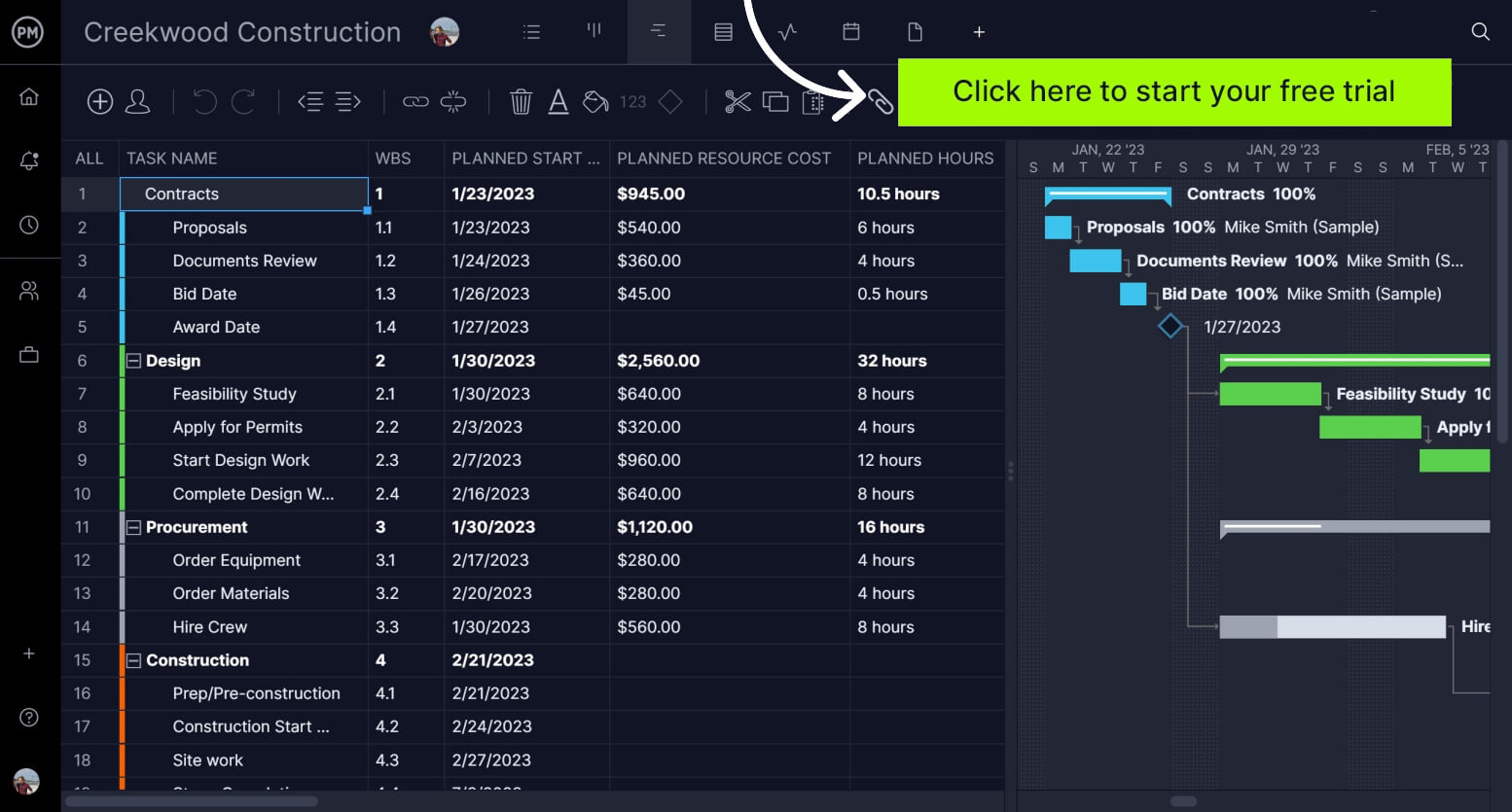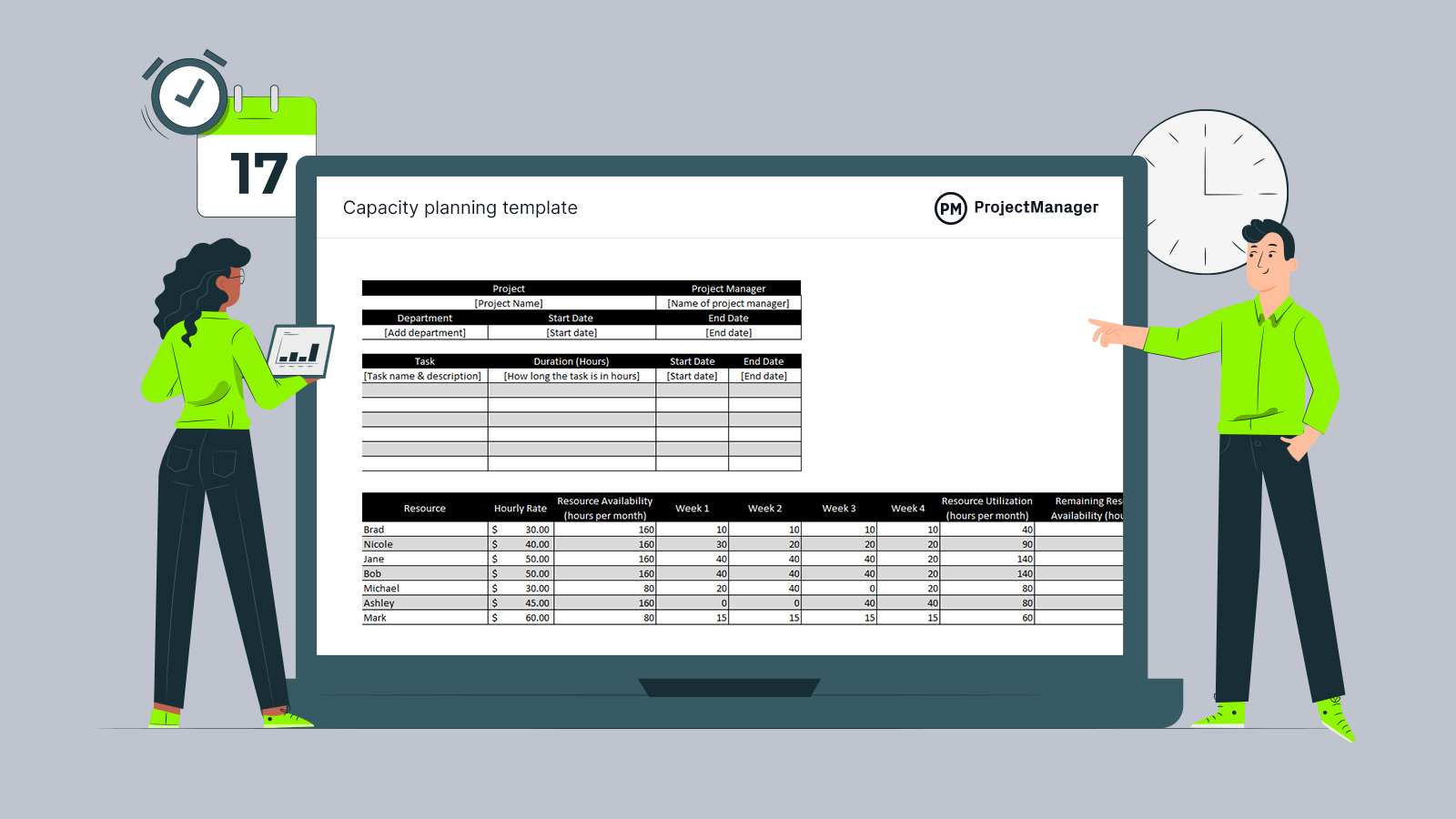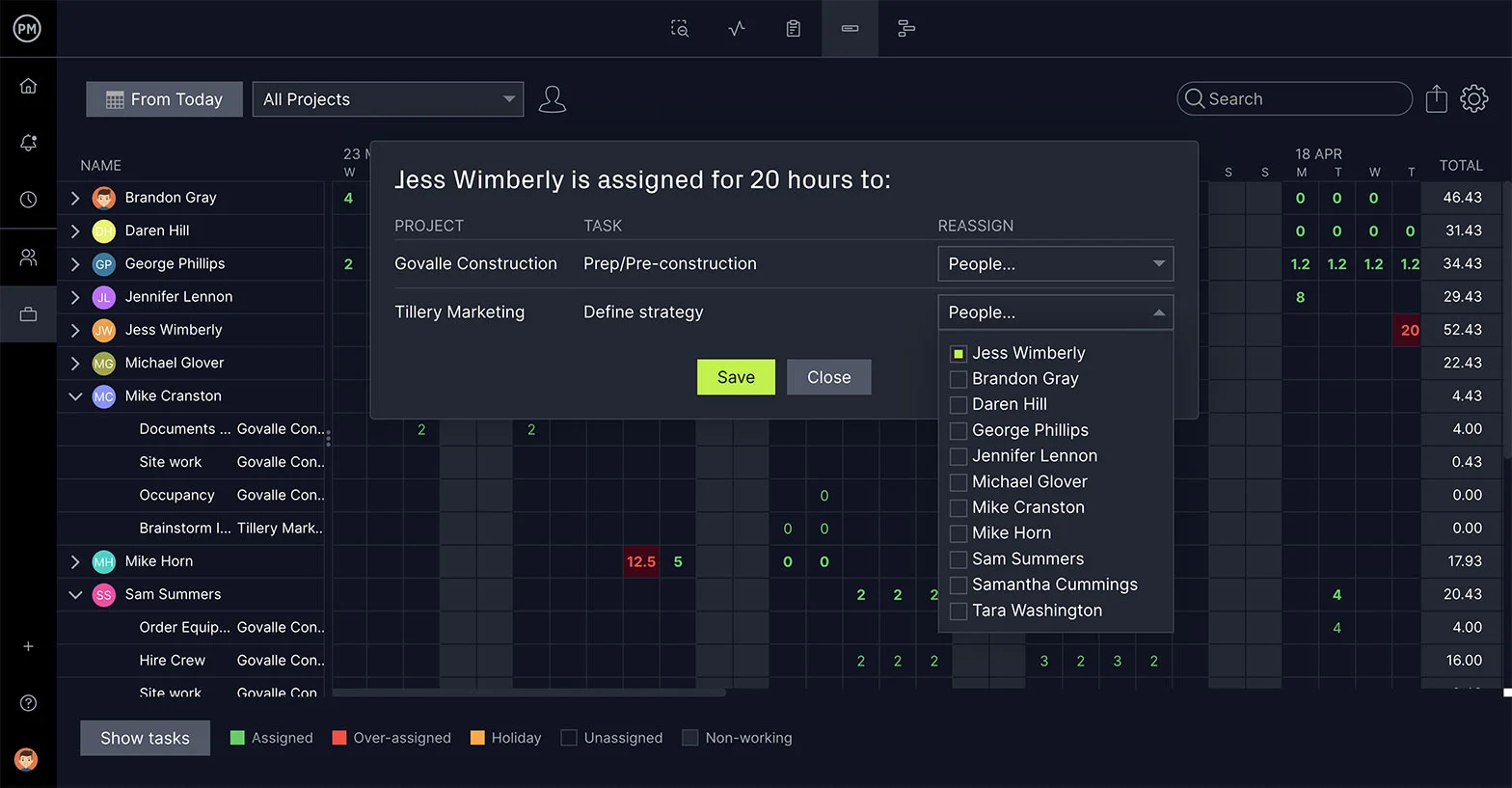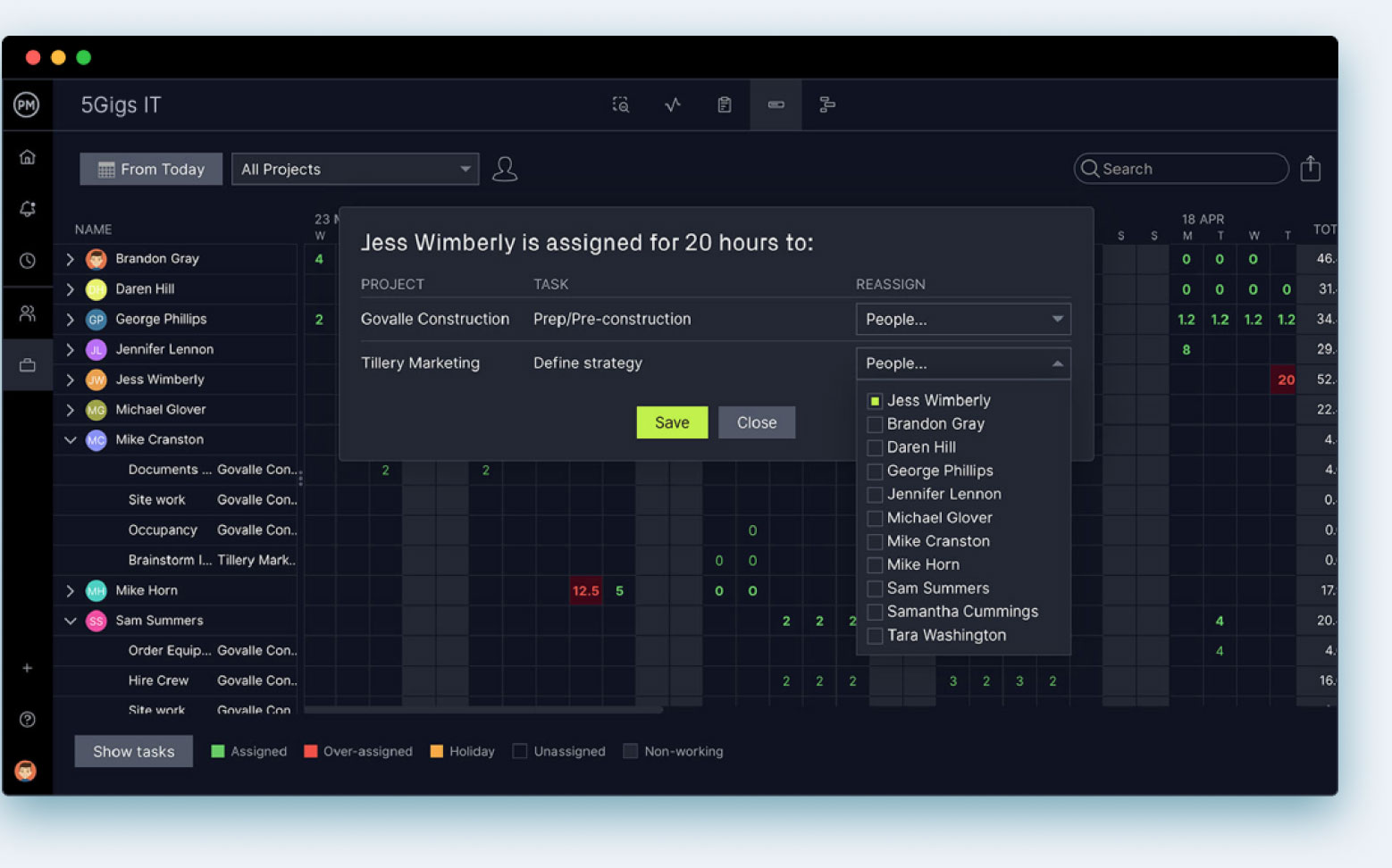If human resources are your most valuable resource, you better give them the attention they need to get their work done. One way to make sure you’re supporting your team and project alike is with workforce planning.
Workforce planning is important and we’ll show you why. Then we’ll help you with the workforce planning process and explain the benefits of using workforce planning in your projects. Finally, we’ll see how project management software allows you to better manage your workforce.
What Is Workforce Planning?
Workforce planning is the overall process of analyzing, forecasting and planning workforce supply and demand. It’s used to avoid gaps in your workforce coverage and determine what skills are needed where and when, at the right cost, to help the project or projects succeed.
The goal of workforce planning is to match the capacity of your workforce with the current and future demands. Being able to accurately forecast workforce demand will also help to identify gaps that allow you to plan to fill those holes with the necessary resources as needed.
With workforce planning, there are most commonly two types: strategic and operational. Strategic workforce planning is used by an organization or its project management office (PMO) to achieve its long-term plans. This requires anticipation of future human resource requirements to ensure that the organization has the skilled workforce to achieve its business objectives.
Strategic workforce planning supports the strategic plan of an organization. It addresses external workforce factors that might impact the larger business and maintains organizational capacity while minimizing risk exposure.
Operational workforce planning is about achieving an organization’s immediate priorities. This type of workforce planning must be focused and realistic to deliver immediate benefits, such as the operation of the organization’s day-to-day activities in an efficient manner. Operational workforce planning will also complement the organization’s strategic planning and long-term goals.
Whichever type of workforce planning you use, project management software will help you do it more effectively and efficiently. ProjectManager is award-winning project management software that helps you plan, manage and track your workforce in real time. Use our powerful Gantt charts to estimate your project resource requirements accurately by making detailed project plans. You can organize your tasks and the associated human resource and nonhuman resource costs, and make sure you have coverage. You can also see the availability of your project team, which makes it easier to assign them to tasks. Get started with ProjectManager today for free.

Why Is Workforce Planning Important?
Workforce planning is important for helping an organization achieve its goals and objectives. Businesses have a vision and a mission that they plan to achieve through projects or a roadmap leading them to future gains. Workforce planning helps them get there.
But short-term goals are as important as long-term ones. They’re the steps that help an organization reach its strategic goals. Effective resource capacity planning addresses the short-term requirements of workforce planning.
Workforce planning also involves the process of forecasting the gap between resource capacity and workload. This allows managers to have the workforce in place to cover those gaps and keep operations running smoothly. Workforce optimization describes the ongoing process of matching the available workforce with changing workforce demands.
Workforce Planning Process
Workforce planning involves having the right people with the right skills at the right time and place for the right cost. That’s easier said than done, which is why we have the five steps you need to take in your workforce planning process to ensure you have the resources you need.
1. Identify the Resources You Need to Run Your Current Operations
The first step is to know what resources you need to keep your operations running. This involves identifying all the resource requirements for your business. That means human resources and workload analysis, but you’ll also want to consider machinery, tools, facilities, the physical area in which they’ll work, vendors, etc.
2. Measure Your Resource Capacity and Utilization Rate
Next, you need to understand your resource capacity and utilization rate. Both of these are ways to measure resource management and are interrelated. Resource capacity is the maximum amount of work, task or project that can be accomplished by a particular resource over time. The resource utilization rate is the amount of an employee’s available time that’s used for productive, billable work.

Get your free
Capacity Planning Template
Use this free Capacity Planning Template for Excel to manage your projects better.
3. Estimate Future Resource Requirements of Your Organization
There are more things to consider than just estimating future resource requirements for the organization. These are some examples of things that can affect the resource requirements of an organization, like a spike in customer demand or a strategic objective that requires the company to increase its production budget:
- New projects
- Customer demand forecasts
- Production budget
- Strategic objectives
- Organizational change
4. Conduct a Skill Gap Analysis
A skill gap analysis measures the difference between the skills that employers want or need against the skills that their workforce offers. This helps with workforce planning to achieve business objectives but also informs both employee development initiatives and hiring programs. You need to identify the skills that are important to the organization and measure your employee’s current skills to see where there are gaps.
5. Take Actions to Balance Workforce Supply and Demand
To keep your workforce at capacity and staying productive requires monitoring. The idea is to balance your workforce supply with the demand you have for that work. This means you have to do things, such as demand and supply forecasting, gap analysis, action planning and always track and evaluate your workforce. You should strive for continuous improvement.
Benefits of Workforce Planning
Effective workforce planning will help you better understand your employees. It’ll allow them to handle the workload assigned to them and give them the training to hone the needed skills to do their jobs the best they can. This will result in not only a more productive workforce working at capacity but also help with employee retention. Your employees will know you want the best from them and that will improve their buy-in for the work and your attrition rate. However, there are many more benefits of workforce planning. Here are a few.
Prepares Organizations to Respond to Changing Business Conditions
Workforce planning has many benefits, but one of the most important is that it recognizes that businesses change and so do their long-term goals. As these changes occur, the workforce has to change with them and sometimes adapt their skills to fit the new business landscape. Workforce planning helps by identifying talent gaps and developing plans to fill those gaps. This also helps one to identify opportunities to develop the skills of your team through training, education funding or graduate programs.
Helps You Control Operational Costs
Workforce planning can reduce labor costs through more effective deployment and flexibility as well as responding to customer needs. Another thing workforce planning can do is help uncover obstacles or unrealistic targets that can get in the way of the organization’s strategic goals. Workforce planning can find solutions that mitigate risk to strategic goals and keep your operational plans under control. Workforce planning leads management to ask questions about what they’re doing and thereby find inefficiencies that they can stop doing to help manage their organizational costs.
Prepares Your Organization to Take on New Challenges
Workforce planning also helps businesses prepare for new challenges by analyzing their current workforce and forecasting future talent needs. Then they can create strategies that will make sure they have the workforce necessary to take on these new challenges by aligning their workforce with those new goals and objectives. It does this by generating data and analyzing that data about both its workforce and coming challenges to make sure that they’re ready for the unexpected. It’s a sort of risk management, where they identify and plan to respond quickly to issues that can potentially impact the business.
How ProjectManager Helps With Workforce Planning
All that is a lot to do on a spreadsheet. Businesses need to not only be organized but have the right tools to help them prepare and respond to changing conditions in the business environment and their workforce. Project management software can help them do this more efficiently. ProjectManager is award-winning project management software with the resource management tools needed to plan, manage and track your workforce in real time.
Balance Your Team’s Workload
Being able to monitor your team’s workload is an essential part of managing your workforce. Once you’ve planned your resources, you can view your team’s task allocation on our color-coded workload chart. It’s easy to see at a glance who has too many or too few assignments. You can then re-allocate your team’s workload right from the chart to keep the team’s workload balanced. This makes everyone work at capacity and keeps them productive.

Track Labor Costs With Timesheets
Workforce planning is part of a business’s larger budget. To ensure that your labor allocation doesn’t break the bank, you need to keep track of those costs in real time. Our secure timesheets help you both track labor costs and streamline your payroll process. You can view timesheets to see how far each team member has gone in completing their tasks and how much they’re costing in terms of their hourly rate. This gives managers a heads-up as to whether they’re meeting or exceeding their budget.

For a high-level overview of labor costs and more, you can toggle over to our real-time dashboard. It automatically collects live project data and displays project metrics in easy-to-read graphs and charts, such as time, cost, workload and more. For more detail, use our customizable reports on timesheets, workload, variance and more. There’s also a status report and portfolio report if you’re managing multiple projects.
ProjectManager is online project management software that connects teams whether they’re in the office, out in the field or anywhere in between. They can share files, comment at the task level and stay updated with email and in-app notifications. Join teams at Avis, Nestle and Siemens who are using our software to deliver successful projects. Get started with ProjectManager today for free.


